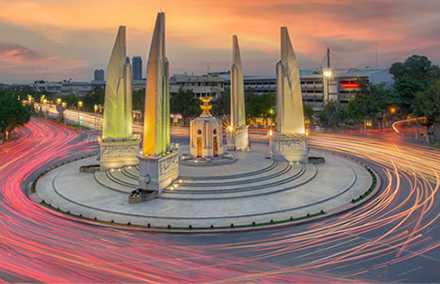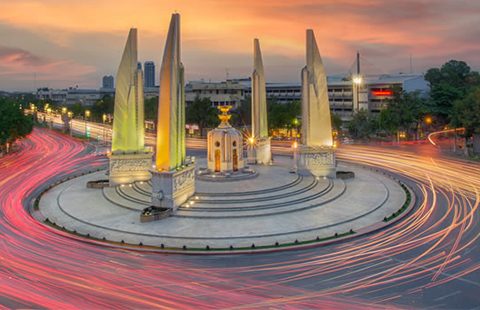
Bangkok’s democracy monument. A relic of the past?
Under Thailand’s new constitution, the military does not have to carry out a coup d’état; the coup has already been written in to law.
Last Saturday, the Constitution Drafting Committee (CDC) concluded its duties, releasing the second and final draft of Thailand’s constitution.
After the release of the first draft in April, the CDC collected comments from the National Council of Peace and Order (NCPO), the National Legislative Assembly (NLA) and the National Reform Council (NRC) to make a revision of the draft. Reading through the final draft reveals notable changes, many of which have major implications.
The upcoming constitution is divided into four main parts; the rights and liberties of Thais; electoral politics; the rule of law, the judiciary, and watchdog agencies; and reform and reconciliation.
The first part resembles that of its 1997 and 2007 predecessors. It covers all standard human and civil rights. However, in contrary to the first draft, it is less enthusiastic on the idea of building a good citizen.
Although the text still demands a long list of desirable behaviors, the CDC abandoned the controversial National Ethics and the Citizen councils, which had been assigned the duty of screening the ethical standard of political office holders.
The second part, elections and public administration, remains largely unchanged from the previous version. MPs will be elected from the Mixed-Member Propositional electoral system to ensure more chances for smaller parties to get in, hence a more fragile government.
The Senate is half-elected and half-nominated. Nomination is complicated because nominees come from different sources; high-ranking civil servants and military top brasses, representatives of professional guilds and non-governmental organisations, and ethical experts from various fields. The prime minister, despite heavy public criticism, still need not be from an election.
More interesting is the third part concerning the rule of law and judicial review. In April, the CDC proposed that, for better transparency, the judicial commission that oversees administration, promotion, and disciplinary action of judicial personnel, shall consist of no less than one-third of non-judge members. The proposal stirred huge backlash and the CDC had to retreat.
The uproar stemmed from the fear that more layperson membership would allow political influence in the administration of justice. The judiciary was successful in warning the CDC, quite harshly, how sensitive the judicial institution feels toward any threat to its independence, no matter how trivial that threat may be.
In general, the judicial turf remains unchanged or even expanded.
In an attempt to avoid populist policies, the constitution draft commands the Administrative Court to establish a new division of fiscal and budgetary disciplines.
All watchdog agencies are placed under the title “the Constitutional Agency to Audit the Exercise of State Power.” Interestingly they are stripped of the word “independent” once given to them by the 1997 Constitution where they first appeared.
The strangest change in the second draft is the combination of a nomination committee of these watchdog agencies. In contrast to the 2007 Constitution, which heavily involved the judiciary in the nomination process, the current draft tried to re-balance by introducing representatives from both sides in the parliament as well as a rector from a public university and a president of local councils.
But the nomination committee also requires a representative from the Joint Standing Committee on Commerce, Industry, and Banking. This committee is a tri-partite panel consisting of the Chamber of Commerce, the Federation of Thai Industry, and the Thai Bankers Association. This might indicate increasing influence from powerful business corporations, many of which are part of the elitist network that funds the anti-Shinwatra movement and the present junta.
Originally the CDC decided to merge the National Human Rights Commission (NHRC) and the Ombudsman into the new rights protecting body. While the NHRC protested that the decision failed to conform to the international standard, the public saw this as a punishment the NHRC deserved for its inertia and bias over previous political crises. Finally, the CDC changed its mind and kept the two as separate bodies.
The CDC also added more severity to an impeachment. An impeachment automatically revokes the political rights of a convicted politician for five years already. But if an impeachment is based on the likelihood of corruption, that politician shall be barred from taking a political office permanently according to the final draft.
The fourth part, where the draft draws most criticisms, is titled “Reform and Reconciliation.” To begin with, the reconciliation chapter is no longer in the Constitution. It shall be described in the organic law on reconciliation which will be prepared by the NLA.
The CDC then made a radical change in the reform blueprint. The first draft created by the National Reform Council consisted of several experts from various fields to spearhead the reform task. The second draft reassigned the duty to the National Strategic Reform Commission (NSRC) in which all commanders of the army, navy, air-force, and police sit alongside experts whom the NLA appoints.
This NSRC is similar to a politburo that oversees and controls the elected government. It has the power to initiate reform policies that constitutionally oblige successive governments. Worse, if the NSRC deems that the country is in crisis, after a consultation with the President of the Constitutional Court and the President of the Supreme Administrative Court, it can intervene “as necessary.”
The language is worryingly vague so it draws no limits to the exercise of this ultimate power. Moreover, this emergency power receives absolute impunity under the new Constitution. The NSRC is then perceived by the public as an attempt by the junta to linger on after a general election. Under the new constitution, the military does not have to carry out a coup d’état because the coup has already been written in to law.
Because the CDC operated in secrecy, no one reliably knows the true explanation for each change in the final draft. But it seems that the moralistic constitution pleased no one, so in order for the draft to be approved, the CDC had to be less radical. It has to compromise to the wishes of those independent bodies and its “employer,” the junta.
Details are delegated to the NLA to decide in a form of organic laws as well as ordinary statutes. The only major resistance now is from the three main political parties, which realise that their victory in the next election will be meaningless.
Although it becomes less obsessed with moral absolutism, the constitution draft reflects more obviously the wish of the elites to entrench their power in Thai politics. It contains several flashpoints for political deadlocks and manipulation.
At the moment, the fate of the constitution draft depends on the NRC. If the NRC accepts the draft, it will proceed to the referendum in early 2016. If not, the CDC will be disbanded and the junta must appoint another commission to draft another one. That will delay the junta’s roadmap to return democracy to this country.
But the junta should be worry-free. Whatever the vote result will be, these soldiers will haunt Thai politics for years to come.
Khemthong Tonsakulrungruang is a constitutional law scholar in Thailand.
 Facebook
Facebook  Twitter
Twitter  Soundcloud
Soundcloud  Youtube
Youtube  Rss
Rss 